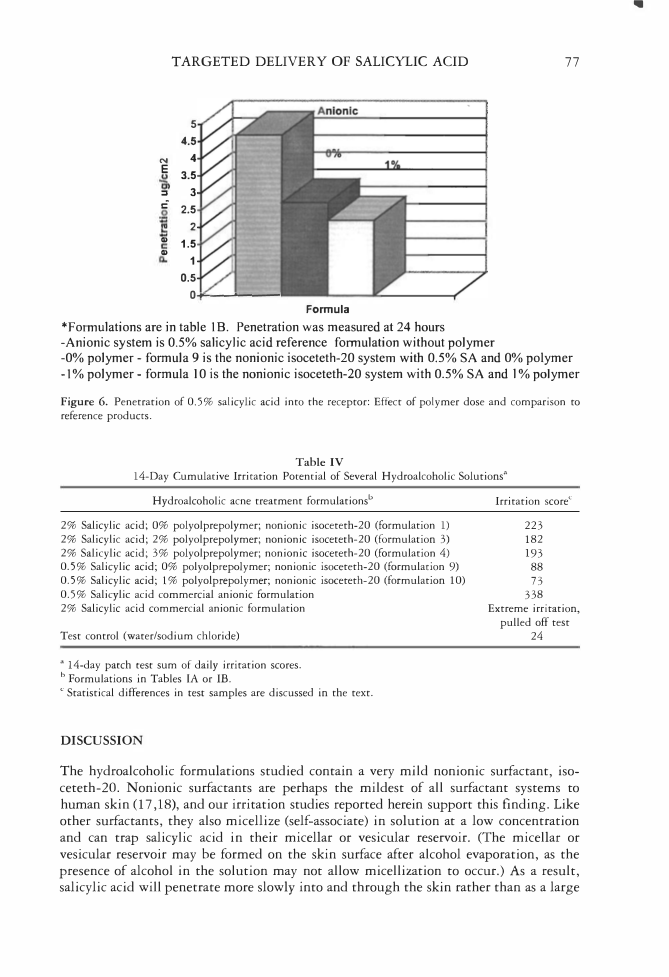76 JOURNAL OF COSMETIC SCIENCE 50 N 45 E ·o 0 40 CJ -� ::I 35 C , 0 30 -� � 25 ii ... en � 20 15 D.. 10 5 ■ Epidermis 0 □ Dermis Form 1 Form4 Form 5 Form 6 Form 7 Formulation Number (3 Receptor *Human skin was used as the substrate * All formulations contained 2% salicylic acid and are shown in table I A with the omissions shown below. Penetration in receptor was measured at 24 hours. TEA is trolamine -Formula 4 contains isoceteth-20 formula, 3% polymer, and TEA -Fommla I contains isoceteth-20, TEA, but no polymer -Formula 5 contains the isoceteth-20, 3% polymer minus TEA -Formula 6 is minus isoceteth-20 but contains 3% polymer and TEA -Formula 7 is minus isoceteth-20 formula minus polymer but contains TEA Figure 5. Salicylic acid penetration into the epidermis, dermis, and receptor from isoceteth-20 formula tions: Synergic effect of polymer and formulation ingredients. lations. We were also interested in comparing the isoceteth system with other surfactant systems. A 14-day cumulative irritation patch test was run on nine formulations. Both 2% salicylic acid and 0.5% salicylic acid formulations were examined. The results are displayed in Table IV. Results show that all 2% salicylic acid nonionic formulations containing 2% and 3% polymer were significantly (p � 0.05) milder than the nonionic prototype without polymer. The anionic formulation with sodium lauryl sulfate was the most aggressive to the skin and significantly worse (p � 0.05) than any other formulation tested. The 2% nonionic isoceteth-20 salicylic formulations were the mildest and even milder than the 0.5% salicylic acid reference anionic surfactant formulation. Thus the amount of salicylic acid in the formulation is not the predominant factor controlling irritation rather, it appears to be the surfactant system. This is due to the aggressive nature of the anionic surfactant system used and also to the lack of a sufficient surfactant micellar content in the formulation (or on the skin surface after the alcohol has evaporated) to retard drug flow through the skin and minimize the concentration of surfactant monomer. Thus, overall the clinical results validate that both the slow release of salicylic acid through the skin, presumably controlled by the polymer, and the change to a milder nonionic surfactant TEA system, appear to translate into reduced irritation.
TARGETED DELIVERY OF SALICYLIC ACID 77 5 4.5 N 4 E 3.5 3 ::I c 2.5 2 Q) 1.5 Q) 1 0.5 o�----- Formula *Forrnu1ations are in table I B. Penetration was measured at 24 hours -Anionic system is 0.5% sa1icylic acid reference forrnu1ation without polymer -0% polymer - formula 9 is the nonionic isoceteth-20 system with 0.5% SA and 0% polymer -1 % polymer - formula 10 is the nonionic isoceteth-20 system with 0.5% SA and 1 % polymer Figure 6. Penetration of 0.5% salicylic acid into the receptor: Effect of polymer dose and comparison to reference products. Table IV 14-Day Cumulative Irritation Potential of Several Hydroalcoholic Solutionsa Hydroalcoholic acne treatment formulations6 2% Salicylic acid 0% polyolprepolymer nonionic isoceteth-20 (formulation 1) 2% Salicylic acid 2% polyolprepolymer nonionic isoceteth-20 (formulation 3) 2% Salicylic acid 3% polyolprepolymer nonionic isoceteth-20 (formulation 4) 0.5% Salicylic acid 0% polyolprepolymer nonionic isoceteth-20 (formulation 9) 0.5% Salicylic acid 1 % polyolprepolymer nonionic isoceteth-20 (formulation 10) 0.5% Salicylic acid commercial anionic formulation 2% Salicylic acid commercial anionic formulation Test control (water/sodium chloride) a 14-day patch test sum of daily irritation scores. 6 Formulations in Tables IA or IB. c Statistical differences in test samples are discussed in the text. DISCUSSION Irritation scorec 223 182 193 88 73 338 Extreme irritation, pulled off test 24 The hydroalcoholic formulations studied contain a very mild nonionic surfactant, iso ceteth-20. Nonionic surfactants are perhaps the mildest of all surfactant systems to human skin (17 ,18), and our irritation studies reported herein support this finding. Like other surfactants, they also micellize (self-associate) in solution at a low concentration and can trap salicylic acid in their micellar or vesicular reservoir. (The micellar or vesicular reservoir may be formed on the skin surface after alcohol evaporation, as the presence of alcohol in the solution may not allow micellization to occur.) As a result, salicylic acid will penetrate more slowly into and through the skin rather than as a large
Purchased for the exclusive use of nofirst nolast (unknown) From: SCC Media Library & Resource Center (library.scconline.org)





































































































































